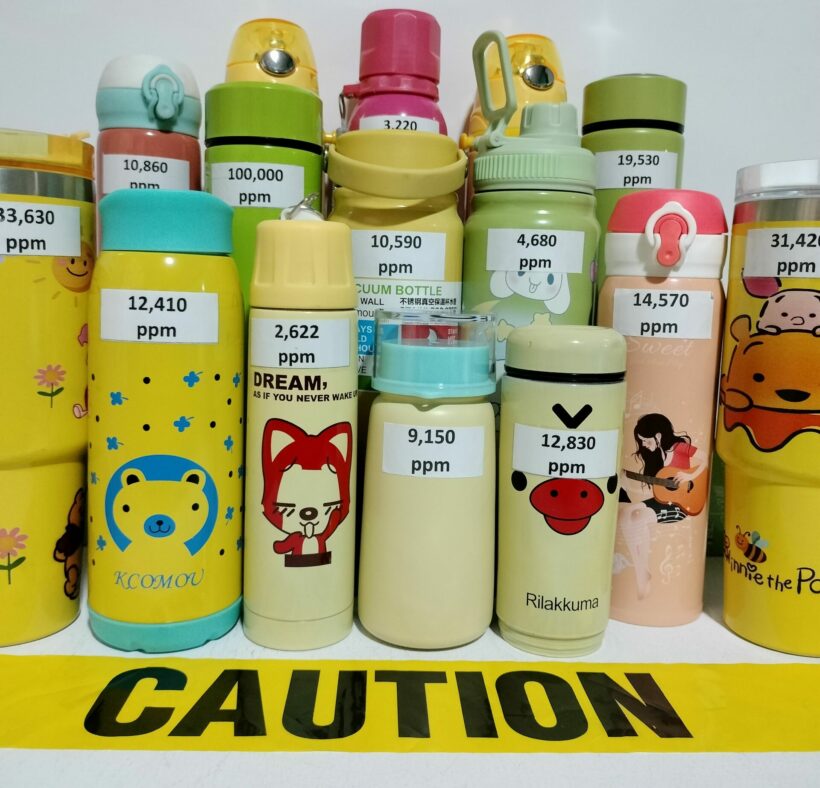8 October 2024, Quezon City. In observance of the Consumer Welfare Month this October and in anticipation of the upcoming International Lead Poisoning Prevention Week on October 20-26, the toxics watchdog group EcoWaste Coalition called on the authorities to enforce the country’s lead paint standard, particularly in painted reusable stainless steel water bottles and tumblers being sold in the market.
The group specifically asked the government to pinpoint the regulatory agency in charge of implementing the said standard in consumer products like water bottles and tumblers, as well as in ensuring the removal of non-compliant products from the market, including online shopping platforms.
The group’s call for governmental action came in the wake of its discovery of several reusable water bottles and tumblers decorated with dangerously high levels of lead-containing paints. Under the DENR Administrative Order 2013-24, lead in paints and similar surface coatings must not exceed the maximum limit of 90 parts per million (ppm).

Some reusable water bottles and tumblers may be coated with paints containing high levels of lead in violation of the 90 parts per million (ppm) limit.
Sold for P145 to P289 each, the samples were purchased by the group between July to October 2024 from online sellers as well as from retail stores located in Antipolo, Caloocan, Manila, and Quezon Cities, and the municipality of Teresa, Rizal Province. Some of the products are decorated with cartoon characters, an indicator that the products are marketed for children’s use.
Of the 30 reusable steel water bottles and tumblers analyzed, the EcoWaste Coalition detected lead above the 90 ppm limit on the exterior coatings of 15 products with the aid of an X-Ray Fluorescence (XRF) device.
Ten of these products contained dangerously high levels of lead in excess of 10,000 ppm, and one of them had over 100,000 ppm lead. None of these products provided lead hazard warnings.
Lead was not detected on the other 15 samples, indicating water bottles and tumblers can be decorated with paints that will not result in lead exposure risks.
While reusable stainless steel water bottles are helpful in decreasing the consumption of single-use plastic water bottles, their manufacturers must comply with the country’s lead paint standard and other applicable standards, the EcoWaste Coalition emphasized.
The presence of lead on the surface coatings of the analyzed water bottles and tumblers is very disturbing, the group said, as the paint will chip over time with repeated use. The lead on the paint may end up being ingested by the user, especially by a child who is unaware of the health risk. Lead is toxic if ingested and can cause adverse health problems.
To assist consumers in choosing water bottles that pose no lead hazard, the group called on manufacturers to duly mark their products as “lead-free” or “lead-safe” as confirmed through third-party certification, and to provide basic product labeling information on the packaging, especially the manufacturer’s and/or distributor’s name and contact details.
The group urged consumers to assert their legal rights to product information and safety in accordance with the Consumer Act of the Philippines, as well as the ASEAN High-Level Principles on Consumer Protection and the UN Guidelines for Consumer Protection.
As stated by the United Nations Children’s Fund (UNICEF), “Lead is a highly poisonous element that is responsible for nearly 1.5 percent of annual global deaths – almost as many deaths as from HIV and AIDS, and more than from malaria.”
“Lead affects a child’s developing brain, causing decreased intelligence, behavioral disorders and learning problems which can reduce potential earnings in adulthood. It also affects almost every organ in a child’s body, including the heart, lungs, and kidneys,” the UNICEF warned.
https://chemical.emb.gov.ph/wp-content/uploads/2017/03/DAO-2013-24-CCO-Lead.pdf
https://www.unicef.org/stories/7-things-know-about-lead-exposure






